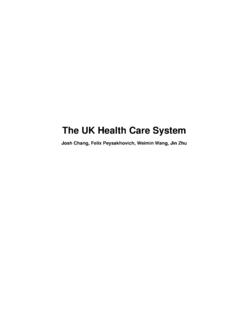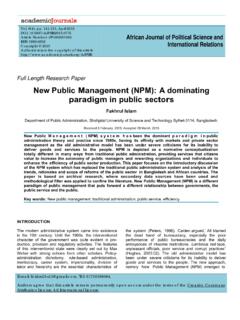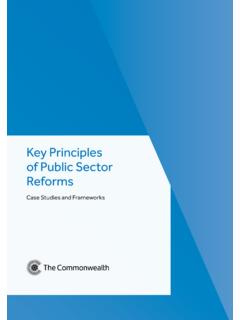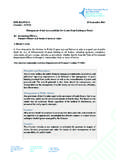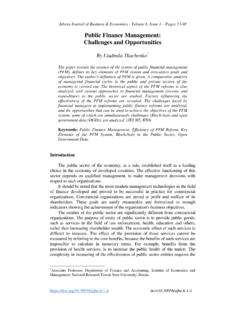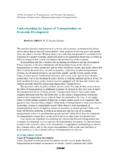Transcription of Public Sector Reform: What Works and Why? - World Bank
1 THE World BANK. Public Sector reform : what Works and Why? An IEG Evaluation of World Bank Support py Co e nc va Ad THE World BANK GROUP. WORKING FOR A World FREE OF POVERTY. The World Bank Group consists of five institutions the International Bank for Reconstruction and Development (IBRD), the International Finance Corporation (IFC), the International Development Association (IDA), the Multilateral Investment Guarantee Agency (MIGA), and the International Centre for the Settlement of Investment Disputes (ICSID). Its mis- sion is to fight poverty for lasting results and to help people help themselves and their environment by providing re- sources, sharing knowledge, building capacity, and forging partnerships in the Public and private sectors. THE INDEPENDENT EVALUATION GROUP. ENHANCING DEVELOPMENT EFFECTIVENESS THROUGH EXCELLENCE AND INDEPENDENCE IN EVALUATION. The Independent Evaluation Group (IEG) is an independent, three-part unit within the World Bank Group.
2 IEG- World Bank is charged with evaluating the activities of the IBRD (the World Bank) and IDA, IEG-IFC focuses on assessment of IFC's work toward private Sector development, and IEG-MIGA evaluates the contributions of MIGA guar- antee projects and services. IEG reports directly to the Bank's Board of Directors through the Director-General, Eval- uation. The goals of evaluation are to learn from experience, to provide an objective basis for assessing the results of the Bank Group's work , and to provide accountability in the achievement of its objectives. It also improves Bank Group work by identifying and disseminating the lessons learned from experience and by framing recommendations drawn from evaluation findings. W O R L D B A N K I N D E P E N D E N T E VA L U AT I O N G R O U P. Public Sector reform : what Works and Why? An IEG Evaluation of World Bank Support 2008. The World Bank Washington, 2008 The International Bank for Reconstruction and Development / The World Bank 1818 H Street NW.
3 Washington DC 20433. Telephone: 202-473-1000. Internet: E-mail: All rights reserved 1 2 3 4 5 10 09 08 07. This volume is a product of the staff of the International Bank for Reconstruction and Development / The World Bank. The findings, interpretations, and conclusions expressed in this volume do not necessarily reflect the views of the Executive Di- rectors of The World Bank or the governments they represent. The World Bank does not guarantee the accuracy of the data included in this work . The boundaries, colors, denomina- tions, and other information shown on any map in this work do not imply any judgement on the part of The World Bank concerning the legal status of any territory or the endorsement or acceptance of such boundaries. Rights and Permissions The material in this publication is copyrighted. Copying and/or transmitting portions or all of this work without permission may be a violation of applicable law.
4 The International Bank for Reconstruction and Development / The World Bank encourages dissemination of its work and will normally grant permission to reproduce portions of the work promptly. For permission to photocopy or reprint any part of this work , please send a request with complete information to the Copyright Clearance Center Inc., 222 Rosewood Drive, Danvers, MA 01923, USA; telephone: 978-750-8400; fax: 978-750-4470;. Internet: All other queries on rights and licenses, including subsidiary rights, should be addressed to the Office of the Publisher, The World Bank, 1818 H Street NW, Washington, DC 20433, USA; fax: 202-522-2422; e-mail: Cover: Mural El Buen Gobierno, by Diego Rivera (1924). Courtesy of Universidad Aut noma de Chapingo, where this mural appears in the Administration Building. ISBN-13: 978-0-8213-7589-1. e-ISBN-13: 978-0-8213-7590-7. DOI: Library of Congress Cataloging-in-Publication Data have been applied for.
5 World Bank InfoShop Independent Evaluation Group E-mail: Knowledge Programs and Evaluation Capacity Telephone: 202-458-5454 Development (IEGKE). Facsimile: 202-522-1500 E-mail: Telephone: 202-458-4497. Facsimile: 202-522-3125. Printed on Recycled Paper Contents vii Abbreviations ix Acknowledgments xi Foreword xiii Executive Summary xix Management Response xxiii Chairperson's Summary: Committee on Development Effectiveness (CODE). 1 1 Objective, Scope, and Method of Evaluation 3 Objectives and Framework 4 Scope 5 Criteria for Evaluation 7 Methods 9 2 Historical Overview of Public Sector reform at the World Bank 11 1946 to 1982: PSR at the Margins 12 1983 to 1989: Focus on Quality of Government 14 1990 to 1996: Increasing Awareness of Governance Agenda 15 1997 to 2007: PSR Efforts Become Central, Include Anticorruption 19 3 World Bank Support for Public Sector reform 21 Lending Projects for Public Sector reform 24 AAA Tasks for Public Sector reform 25 Institutional Development Grants 25 Country Portfolios of PSR Activities 28 Thematic Distribution of PSR Projects 30 Staffing for PSR.
6 33 4 How Public Sector reform Outcomes Differ by Country Groups 35 Measurement, Attribution, and the Role of Governments, the Bank, and Donors 37 Summary Results 38 IEG Project Ratings 40 Reasons for Country Differences iii P U B L I C S E C T O R R E F O R M : W H AT W O R K S A N D W H Y ? 43 5 Public Sector reform Outcomes and Performance by Thematic Area 45 Overview of Thematic Differences 64 Summary Lessons from Thematic Comparisons 67 6 Strategic Summary, Ratings, and Recommendations 69 reform Motivations, Expectations, and Success Factors 71 Country PSR Strategy Entry Points 72 Summary Evaluation Ratings 73 Recommendations 77 Appendixes 79 A: Data Set Description: Public Sector reform Lending, AAA, and Institutional Development Funds 81 B: Statement by the External Advisory Panel These appendixes are available online at C: Public Sector reform Project List, Fiscal 1990 2006. D: Public Sector reform Advisory and Analytical Activities, Fiscal 1999 2006.
7 E: Public Sector reform Institutional Development Funds, Fiscal 1992 2006. F: Clients and Other External Stakeholders Interviewed 83 Endnotes 87 Bibliography Boxes 5 Scope of Review of the Bank's Anticorruption Activity 36 Pros and Cons of CPIA as a Governance Measure 50 Too Much Attention to the Technical Aspects Not Enough to the Human Element in Ghana 62 Extractive Industries Transparency Initiative Multi-Donor Trust Fund Figures xiv Lending Projects with Significant PSR Components, 1990 2006. 22 Lending Projects with Significant PSR Components, 1990 2006. 23 Lending Value in Projects with a Significant PSR Component 23 Regional Distribution of Public Sector reform Projects 28 Themes Included in Projects with Significant PSR Funding 29 Public Sector reform Conditions 54 Number of CSA Projects with Various Subcategories of Conditions Tables 6 Results Framework for Public Sector reform 7 Case Study Countries 24 Public Sector reform AAA Products iv CONTENTS.
8 26 IDF Grants on Public Sector reform Themes 26 Public Sector reform Lending and AAA Activities in Relation to Public Sector Governance 31 Public Sector Staffing and Specialties by Region 38 Percent of Countries with Improved CPIA Governance Scores by PSR Theme and IDA/IBRD Classification 39 Percent of Countries with Improved Governance CPIA Scores by Region, 1999 2006. 39 Summary of IEG Project Ratings for Closed PSR Projects, 1999 2006. 46 Changes in Selected CPIA Scores by PSR Theme, Initial Governance Score, and IDA/IBRD Classification 49 Improvement Rates in Public Financial Management (CPIA 13) by IDA/IBRD. Classification 53 Civil Service and Administrative reform : Types and Challenges 59 State Capture and Bureaucratic Corruption, and Indirect Ways to Combat Them 72 Overall Bank Performance Ratings, 1999 2006. v Central post office in Morrocco. Photo by Julio Etchart, courtesy of the World Bank Photo Library.
9 Abbreviations AAA Analytical and advisory activities ACT Anticorruption and governance (transparency). BEEPS Business Environment and Enterprise Performance Survey CAS Country Assistance Strategy CEM Country Economic Memorandum CFAA Country Financial Accountability Assessment CPAR Country Procurement Assessment Report CPIA Country Policy and Institutional Assessment CSA Civil service and administrative ( reform ). DPL Development Policy Loan DFID Department for International Development (United Kingdom). DPR Development Policy Review EITI Extractive Industries Transparency Initiative ESW Economic and Sector work GAC Governance and anticorruption (strategy). HIPC Heavily indebted poor countries IBRD International Bank for Reconstruction and Development ICRG International Country Risk Guide IDA International Development Association IDF Institutional development funds IEG Independent Evaluation Group IGR Institutional and Governance Review IMF International Monetary Fund MTEF Medium-term expenditure framework NGO Nongovernmental organization OECD Organisation for Economic Co-operation and Development OPCS Operations Policy and Country Services PEFA Public Expenditure and Financial Accountability PER Public Expenditure Review PETS Public expenditure tracking surveys PFM Public financial management PIU Project implementation unit PPAR Project Performance Audit Report PREM Poverty Reduction and Economic Management Network PRSC Poverty Reduction Support Credit PSG Public Sector governance PSM Public Sector management PSR Public Sector reform SAL Structural Adjustment
10 Loan TAX Tax administration ( reform ). WBI World Bank Institute WDR World Development Report vii Government building in Hanoi, Vietnam. Photo Galen Frysinger. Acknowledgments This evaluation of the World Bank's support for Peters. Cheryl Gray, Director of IEG World Bank Public Sector reform was prepared by the Coun- during the final phases of preparing the evalua- try Evaluation and Regional Relations division in tion, recused herself from management oversight the Independent Evaluation Group (IEG). because of her earlier key role in the Public sec- tor reform agenda. The team was led by Steven Webb and comprised Milka Casanegra (tax administration), Corky de Colum Garrity, Gregory Kisunko, and others on Asis, Tim De Vaan, Anne Evans (civil service and the Public Sector and Governance Sector Board administrative reform ), Odd-Helge Fjeldstad (an- were generous in helping gather information. ticorruption), Ilka Funke (assistant team leader), Gita Gopal, Ina Hoxha, Keith Kranker (database The peer reviewers Catherine Gwin, Roumeen and statistical analysis), Evelina Mengova (data- Islam, and Marcelo Selowsky gave useful sug- base), Victor Orozco (database and statistical gestions at several stages of the process, as did sev- analysis), Vikki Taaka (logistics and document eral other colleagues in IEG.)











